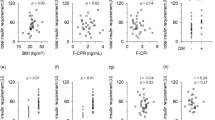Abstract
Purpose
Continuous intraperitoneal insulin infusion (CIPII) with an implantable pump is safe and effective in selected subjects with diabetes. Our aim was to assess surgical experience and complications with CIPII.
Methods
We performed a retrospective longitudinal observational cohort study of patients that started with CIPII from 1990 to 2006. Operation free period and complication rate were compared between patients initiating CIPII before 2000 and from 2000 onwards.
Results
In 63 patients, 166 re-operations were performed during 381 patient-years. Re-operations were pump replacement due to end-of-battery life (47%), laparoscopic catheter-related procedures (29%) and other interventions (24%). Median operation free period increased from 21 to 78 months from 2000 onwards (p = 0.039). Nineteen percent of patients developed complications. No operation-related mortality was reported.
Conclusions
Increased experience together with technical improvements has led to an increase of the operation free period. The absence of procedure-related mortality and a low complication rate makes CIPII feasible for selected patients with diabetes.


Similar content being viewed by others
References
Dunn FL, Nathan DM, Scavini M et al (1997) Long-term therapy of IDDM with an implantable insulin pump. The Implantable Insulin Pump Trial Study Group. Diabetes Care 20:59–63 doi:10.2337/diacare.20.1.59
Nathan DM, Dunn FL, Bruch J et al (1996) Postprandial insulin profiles with implantable pump therapy may explain decreased frequency of severe hypoglycemia, compared with intensive subcutaneous regimens, in insulin-dependent diabetes mellitus patients. Am J Med 100:412–417 doi:10.1016/S0002-9343(97)89516-2
Schade DS, Eaton RP, Spencer W (1980) Normalization of plasma insulin profiles in diabetic subjects with programmed insulin delivery. Diabetes Care 3:9–14 doi:10.2337/diacare.3.1.9
Selam JL, Micossi P, Dunn FL et al (1992) Clinical trial of programmable implantable insulin pump for type I diabetes. Diabetes Care 15:877–885 doi:10.2337/diacare.15.7.877
Broussolle C, Jeandidier N, Hanaire-Broutin H (1994) French multicentre experience of implantable insulin pumps. The EVADIAC Study Group. Evaluation of Active Implants in Diabetes Society. Lancet 343:514–515 doi:10.1016/S0140-6736(94)91462-1
Saudek CD, Duckworth WC, Giobbie-Hurder A et al (1996) Implantable insulin pump vs multiple-dose insulin for non-insulin-dependent diabetes mellitus: a randomized clinical trial. Department of Veterans Affairs Implantable Insulin Pump Study Group. JAMA 276:1322–1327 doi:10.1001/jama.276.16.1322
Logtenberg SJ, van Ballegooie E, Israel-Bultman H et al (2007) Glycaemic control, health status and treatment satisfaction with continuous intraperitoneal insulin infusion. Neth J Med 65:65–70
Selam JL, Raccah D, Jean-Didier N et al (1992) Randomized comparison of metabolic control achieved by intraperitoneal insulin infusion with implantable pumps versus intensive subcutaneous insulin therapy in type I diabetic patients. Diabetes Care 15:53–58 doi:10.2337/diacare.15.1.53
Udelsman R, Chen H, Loman K et al (1997) Implanted programmable insulin pumps: one hundred fifty-three patient years of surgical experience. Surgery 122:1005–1011 doi:10.1016/S0039-6060(97)90202-6
Udelsman R, Boyne MS, Loman KE et al (2000) Intraperitoneal delivery of insulin via mechanical pump: surgical implications. Langenbecks Arch Surg 385:367–372 doi:10.1007/s004230000155
Thompson JS, Duckworth WC, Saudek CD et al (1998) Surgical experience with implantable insulin pumps. Department of Veterans Affairs Implantable Insulin Pump Study Group. Am J Surg 176:622–626 doi:10.1016/S0002-9610(98)00273-6
Gin H, Renard E, Melki V et al (2003) Combined improvements in implantable pump technology and insulin stability allow safe and effective long term intraperitoneal insulin delivery in type 1 diabetic patients: the EVADIAC experience. Diabetes Metab 29:602–607 doi:10.1016/S1262-3636(07)70075-7
Renard E, Schaepelynck-Belicar P (2007) Implantable insulin pumps. A position statement about their clinical use. Diabetes Metab 33:158–166 doi:10.1016/j.diabet.2006.10.004
Darouiche RO (2004) Treatment of infections associated with surgical implants. N Engl J Med 350:1422–1429 doi:10.1056/NEJMra035415
Moss AJ, Zareba W, Hall WJ et al (2002) Prophylactic implantation of a defibrillator in patients with myocardial infarction and reduced ejection fraction. N Engl J Med 346:877–883 doi:10.1056/NEJMoa013474
Haardt MJ, Selam JL, Slama G et al (1994) A cost-benefit comparison of intensive diabetes management with implantable pumps versus multiple subcutaneous injections in patients with type I diabetes. Diabetes Care 17:847–851 doi:10.2337/diacare.17.8.847
Dufaitre-patouraux L, Riveline JP, Renard E et al (2006) Continuous intraperitoneal insulin infusion does not increase the risk of organ-specific autoimmune disease in type 1 diabetic patients: results of a multicentric, comparative study. Diabetes Metab 32:427–432 doi:DM-11-2006-32-5-1262-3636-101019-200519823
Acknowledgements
We wish to thank Dr Evert van Ballegooie for his continuing support for this patient group during his lifetime. He is missed both by his patients and his colleagues.
Financial interest
None.
Author information
Authors and Affiliations
Corresponding author
Electronic supplementary material
Below is the link to the electronic supplementary material.
423_2008_437_MOESM1_ESM.pdf
Supplementary Material Table Cox regression: time between first and second operation in patients started on CIPII before compared to in or after 2000, corrected for confounders (PDF 13 KB)
Rights and permissions
About this article
Cite this article
Haveman, J.W., Logtenberg, S.J.J., Kleefstra, N. et al. Surgical aspects and complications of continuous intraperitoneal insulin infusion with an implantable pump. Langenbecks Arch Surg 395, 65–71 (2010). https://doi.org/10.1007/s00423-008-0437-9
Received:
Accepted:
Published:
Issue Date:
DOI: https://doi.org/10.1007/s00423-008-0437-9




